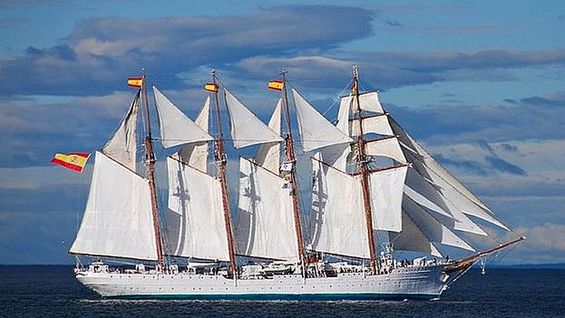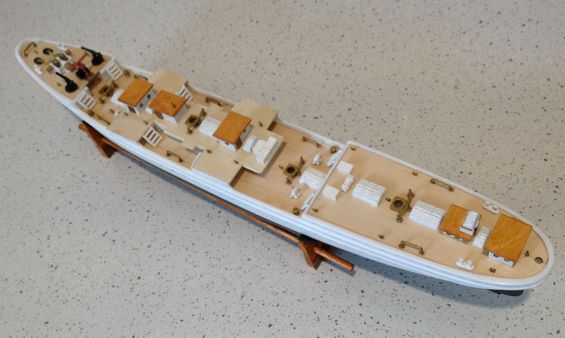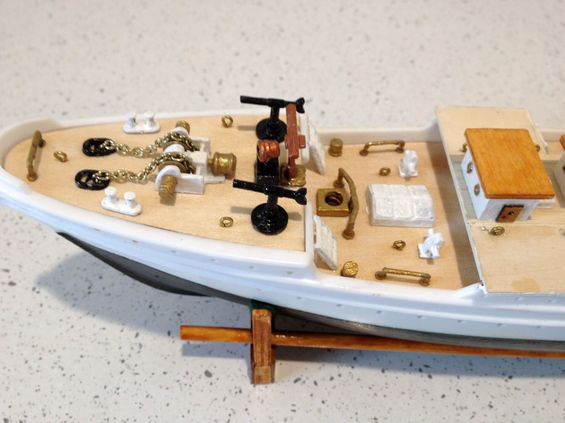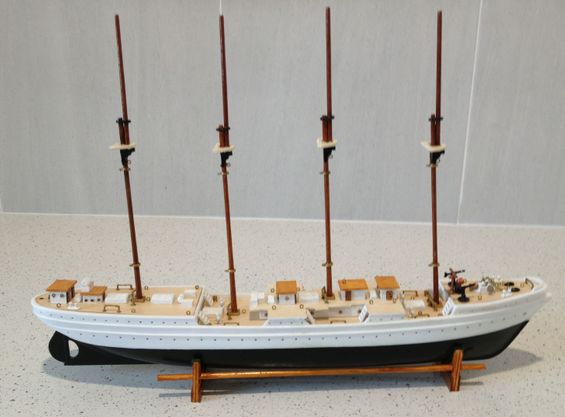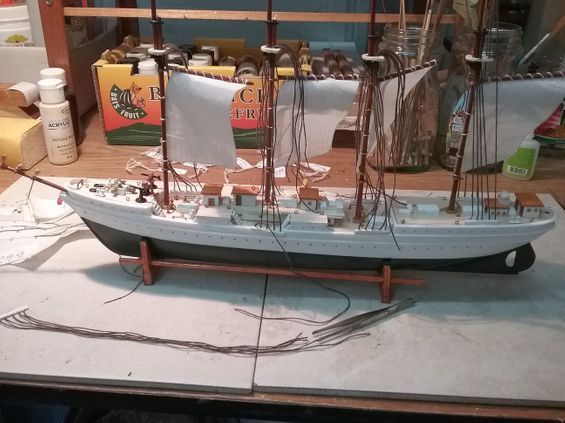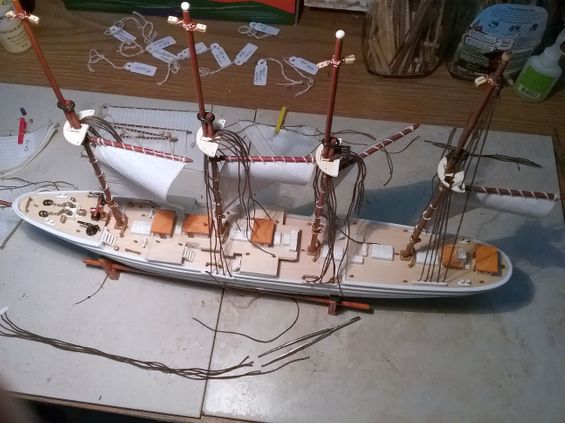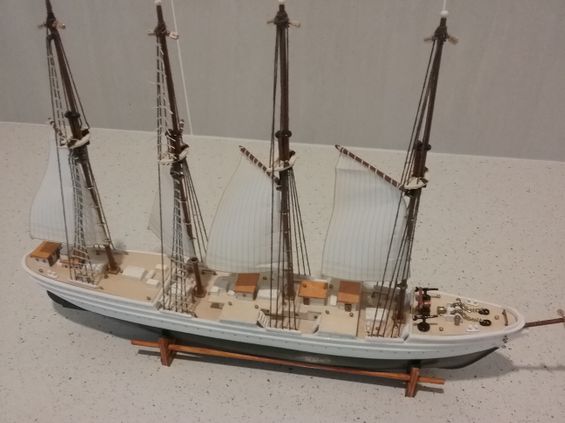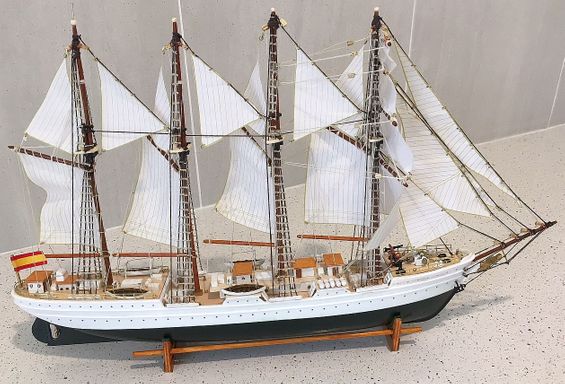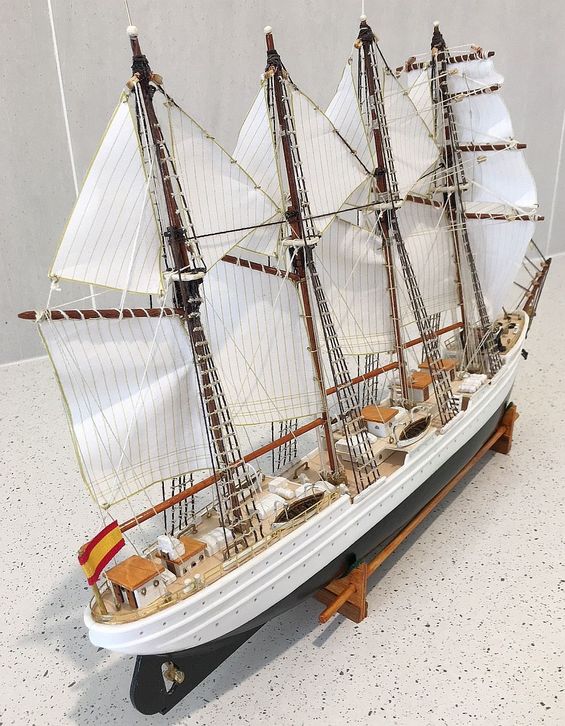Clasic Ship Model 14
Juan Sebastian Elcano - Spanish Naval Training Vessel of 1927
This Spanish Naval Training Vessel is described as a 4 masted Schooner or as otherwise a four masted fully rigged brig-schooner. She was built in 1927 by Echevarrieta and Larinaga of Cadiz and is one of the oldest of the Tall Ships still in operation. Being affiliated to the Sail Training Association, she participates in many of the grand Ocean Racing events in the world. In preparation for the 3,600 mile race between Lisbon and Hamilton in 1964 her sails were adjusted to give her more speed. She is now capable of speeds in excess of 15 knots.
Over time, the vessel has visited 68 countries and 181 different ports worldwide. She has a crew of 36 Officers, 143 cadets and 70 marines. She is equipped with two saluting cannons and has a length of 94.13 metres.
J S Elcano, the model
The diagram here indicates the names of all the sails and some fittings, section names etc which is very useful for the beginners of ship model making. The model selected to build is from the Artesania Latina stable and has a scale of 1:250. The reason this 'beginners' model was bought is because the larger model available was beyond budget and another Training Vessel was appropriate to compliment the previous three models made.
The hull with deck fittings in place
Having a moulded hull which only required painting below the waterline, it was the first job to assemble the deck houses, sand and paint them with three coats plus the many cast fittings supplied. These all needed careful placement before gluing as space was very limited and it had to be exact. Artesania provide excellent pictures of the building process but there is also a need to follow these in conjunction with constant reference to the plans provided.
As there was no stand supplied in the kit, it was imperative to have something to hold the very lightweight hull in steady position as the deck work was done and the later to provide a display stand. Thus one was tailor made to fit the hull toward the bow and to the stern. This can be seen in the photographs.
The bow section
This shows the space on the bow including the saluting cannons, securing points and the windlass etc. The forward well deck is also shown with the forward hatch prominent as is the foremast seating, securing points and the forward deck house which is actually the navigating bridge.
The four masts now built
The four masts have now been consructed with the top masts also secured. They are in temporary position to ensure the correct alignment in the future when secured. Before this happens, all the blocks and and gaff fittings have to be installed on the masts. All the sails need to be cut out from sheet supplied, appropriate holes made in them for attaching split rings to the masts and the square sails sewn on the yards. In the case of this model, the shrouds for the ratlines are glued to timber sections attached to the bulwarks and then, when the masts are glued in place, the shrouds are threaded through the cast foretops and glued. Clearly this system is advised as the size of the components make the normal procedure impractical.
Shrouds and ratlines plus sails are underway
In the workshop! This shows how the shrouds are made up by being glued at the base on to timber sections ready to be glued on the bulwarks or, in the case of the jigger mast (the furthest aft mast) to the deck. The shrouds on the Jigger mast have been fitted, the Mizzen the Main mast are just started and the foremast yet to be commenced - it's bundle of shrouds are lying on the work bench in the foreground. One can also see, in the background, the sails that have been made up and labelled so as to avoid errors!
An Overhead view
This photo from above shows some parts mentioned above, more clearly.
Shrouds all fitted and Ratlines underway 001
The shrouds were fitted as described earlier and the ratlines commenced, working on the starboard side from aft. The instructions indicated the ratlines should be tap glued into place but the conventional method of knotting each one with clove hitches was adopted. Although painstakingly slow it is much more satifying and authentic.
A beige cotton was used in contrast to the dark brown of the shrouds and they show up well. To do this in such a small scale model needs the application of good fine tweezers, good eyesight and a steady hand. The tensions on the shrouds are not as good with them being glued top and bottom as opposed to being secured to dead eyes and chain plates and knotted to the masts. Thus it is difficult to obtain perfect results.
Shrouds all fitted and Ratlines underway 002
Just another view to emphasise the previous text. Those viewers with a keen eye may be able to see the ratlines on the Mizzen topmast have yet to be trimmed.
Model completed
After two months of concentrated effort, the model is now complete and ready for display. Reasonable progress was made in the past month but a few hurdles had to be overcome. These will be referred to in the texts following where two other views of the vessel can be seen.
Personal observations during construction
Prologue: Although the model is rated for the beginner, it is not an easy introduction to the craft. Being an extremely small model (1:250 scale) with a moulded hull, yet involving a great deal of detail, it does require a lot of concentration and care.
The instruction booklet is a credit to Artesania Latina having excellent photos, diagrams and text in its "Order of work" which needs to be followed. For a first attempt however, it would be a real challenge.
***************************************************************************************************
1. The masts - Joining the topmasts to the mains. The 'cap shores' were holed to take the two masts and the foretops had an open 'slot' in the casting but neither allowed any space between the two masts. Hence, when the plan required rigging to be made fast around one, they had to circumvent both - resulting in a 'bulking' of lines.
2.The sails - these were cut from one piece of very fine sail cloth, clearly marked with the correct shapes but without the ability to sew the edges. Needle holes had to be made close to the edges to accommodate the small rings. During rigging, these frequently 'pulled out' as soon as any pressure was applied thus requiring a second hole to be made. When this occurred, it was the time to touch glue the surrounds of the rings with aquadere as a precaution.
(continued below)
View from forrard
3. Securing the rigging - Due to the scale (1:250) and the amount of rigging involved, the masts and yards accumulated an inordinate amount of threads and the securing points, particularly at the base of the masts were well utilised!
4. The Guard Rails - these were fitted at the very end of the construction and were a real challenge! Supplied in a very fine flat brass cut sheet, they were in five sections - three for the poop deck and two for the bows. they comprised of two horizontal bars and regularly spaced verticals which protruded about 3mms below the bar. As the deck line was almost flush with the upper mouldings of the hull, there was no support available to which they needed for support. As a result, the 3mms sections were bent at right angles , touch glued with YHU adhesive -and it worked!! (This was after much thought when the Zap-a-Gap instant glue failed). The kit wanted them painted white but a decision was made to leave them in brass.
(continued below)
View from aft
5. Final Resting Place - It may be possible to see that the model is mounted with a lean to port which, with the sails being set and the flag flying accordingly, she has the wind from the starboard quarter. The kit photograph shows all her sails being set fore and aft except the square sails are billowing and the flag indicating the wind is from forrard. As has been stated previously on this site, the models made over recent years have not been fitted with sails as it is believed not to be authentic as the models are always mounted completely upright - as though they are in drydock where the sails are never rigged! In this case, it was felt the model would not be interesting to viewers with four bare equally tall masts. Therefore an exception to personal views was made and it had to be mounted as though under sail.!

